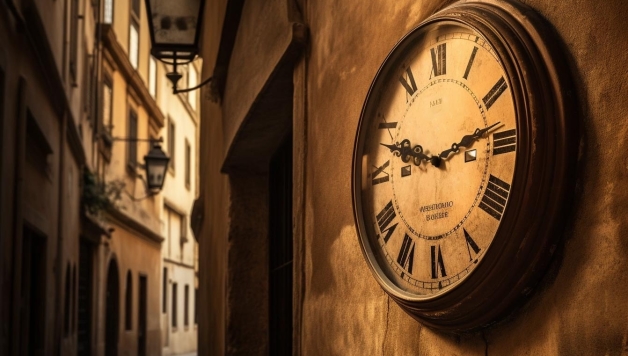Here you can learn how to tell the time, the days of the week, and the months of the year in Italian:
Telling Time
In Italian, when telling the time, the 24-hour clock system is commonly used.
- What time is it? : Che ora è? (keh O-rah eh)
- It's one o'clock. : È l'una. (eh LOO-nah)
- It's two o'clock. : Sono le due. (SO-noh leh DOO-eh)
- It's three o'clock. : Sono le tre. (SO-noh leh TREH)
Here's a selection of times in Italian, demonstrating different ways to express minutes past, minutes to, quarter hours, and half past:
- 1:00 : L'una (LOO-nah)
- 2:15 : Le due e un quarto (leh DOO-eh eh oon KWAHR-toh)
- 3:30 : Le tre e mezza (leh TREH eh MEHT-tsah)
- 4:45 : Le cinque meno un quarto (leh CHEEN-kweh MEH-noh oon KWAHR-toh)
- 5:30 : Le cinque e mezza (leh CHEEN-kweh eh MEHT-tsah)
- 6:20 : Le sei e venti (leh SEH-ee eh VEN-tee)
- 7:45 : Le otto meno un quarto (leh OHT-toh MEH-noh oon KWAHR-toh)
- 8:30 : Le otto e mezza (leh OHT-toh eh MEHT-tsah)
- 9:10 : Le nove e dieci (leh NOH-veh eh DYEH-chee)
- 10:50 : Le undici meno dieci (leh oon-DEE-chee MEH-noh DYEH-chee)
- 11:40 : Le dodici meno venti (leh doh-DEE-chee MEH-noh VEN-tee)
- 12:15 : Le dodici e un quarto (leh doh-DEE-chee eh oon KWAHR-toh)
These examples showcase various ways to express time in Italian, including the use of "meno" (to), "e" (past), and specific terms for quarter hours and half past. Learning how to tell time accurately will greatly enhance your ability to schedule appointments, catch transportation, and coordinate activities in Italian-speaking contexts.
In Italian, the verb "sono" is used to indicate the time when expressing it in a complete sentence. It is equivalent to the English phrase "It is" when referring to the time. The use of "sono" helps establish the subject of the sentence (referring to the hour) and indicates the current time. It is a common practice in Italian to include the verb "sono" when stating the time.
Days of the Week
Here are the days of the week in Italian:
- Monday : Lunedì (loo-neh-DEE)
- Tuesday : Martedì (mar-teh-DEE)
- Wednesday : Mercoledì (mer-ko-leh-DEE)
- Thursday : Giovedì (jo-veh-DEE)
- Friday : Venerdì (ve-neh-dee)
- Saturday : Sabato (sah-BAH-toh)
- Sunday : Domenica (do-MEH-nee-kah)
Months of the Year
Here are the months of the year in Italian:
- January : Gennaio (jen-NAH-yoh)
- February : Febbraio (feb-BRAH-yoh)
- March : Marzo (MAR-tsoh)
- April : Aprile (ah-PREE-leh)
- May : Maggio (MAH-joh)
- June : Giugno (JOO-nyoh)
- July : Luglio (LOO-lyoh)
- August : Agosto (ah-GOHS-toh)
- September : Settembre (set-TEM-breh)
- October : Ottobre (ot-TOH-breh)
- November : Novembre (no-VEHM-breh)
- December : Dicembre (dee-CHEM-breh)
Learning how to tell the time and familiarizing yourself with the days of the week and months of the year will greatly enhance your ability to communicate and navigate daily life in Italian.

